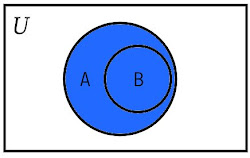Common problems from the short multiplication formulas
1 Problem Find the numerical value of the expression a^2+b^2 if a+b=5 and ab=9.
Solution: Let's recall the formula for truncated multiplication (a+b)^2=a^2+2ab+b^2, which we have already reviewed here. Notice that a^2+b^2=(a+b)^2-2ab, this is because (a+b)^2-2ab=a^2+2ab+b^2-2ab, and the ones complement 2ab and -2ab are truncated. Thus, we have already figured out how to represent a^2+b^2 as the sum and product of a and b, hence a^2+b^2=(a+b)^2-2ab=5^2-2.9=25-18=7.
Problem 2 Prove the identity (ab+cd)^2=(a^2+c^2)(b^2+d^2)-(ad-cb)^2.
Solution: We need to prove that the left side of this equality is equal to the right side. We will simplify both sides of the equality and compare them, hence LS=a^2b^2+2abcd+c^2d^2. Now we simplify the right-hand side of the equality
LS=a^2b^2+a^2d^2+b^2c^2+c^2d^2-(a^2d^2-2adcb+c^2b^2)=
=a^2b^2+a^2d^2+b^2c^2+c^2d^2-a^2d^2+2adcb-c^2b^2=a^2b^2+c^2d^2+2abcd.
Thus we get that LS=RS and the equality is an identity.
Problem 3 Calculate x^3+y^3 if x+y=t and x^2+y^2=k.
Solution: It is now well known that x^3+y^3=(x+y)(x^2+xy+y^2), a formula we have already considered here. We write the above equality as follows x^3+y^3=(x+y)(x^2+y^2+xy). We already know from the problem condition that x+y=t and x^2+y^2=k, so x^3+y^3=t(k+xy). Now we need to express xy, in terms of t and k. We have already seen from Problem 1 in this lesson that a^2+b^2=(a+b)^2-2ab and hence 2ab=(a+b)^2-(a^2+b^2), where xy=\frac{t^2-k}{2}. We replace xy by \frac{t^2-k}{2}, whence x^3+y^3=t(k-\frac{t^2-k}{2})=\frac{t}{2}(3k-t^2).
4 Problem Put the polynomial B=\frac{(x-m)^2}{2}+\frac{(m-x)(m+x)}{4}-\frac{x(3x-m)}{12} into normal form.
Solution: The common denominator of the three fractions is obviously 12, we bring the fractions under common denominator and get B=\frac{6(x-m)^2+3(m-x)(m+x)-x(3x-m)}{12}=\frac{6x^2-12mx+6m^2+3m^2-3x^2-3x^2+mx}{12}=
=\frac{9m^2-11mx}{12}=\frac{3}{4}m^2-\frac{11}{12}mx.
5 Problem Does the value of the expression (x+11)^2+(x-11)^2-3(x-3)(x+3) depend on the values of x?
Solution: In order to answer the question posed, we need to reveal the parentheses and perform the apparitions. If we then get a constant, i.e. a number, it means that the expression does not depend on the value of x, if we get a singleton or polynomial involving x then the value of the expression depends on the value of x. We open the parentheses (x+11)^2+(x-11)^2-3(x-3)(x+3)=x^2+22x+121+x^2-22x+121-2(x^2-9)=x^2+22x+121+x^2-22x+121-2x^2+18. Notice that all the monomials involving x are truncated and the given expression equals 260. From this we conclude that whatever the value of x this expression will always be equal to 260 i.e. the answer to the question posed is that the value of the expression does not depend on the values of x.
6 Problem Compare the numerical values of A=(x-2)(x^2+2x+4)-(x-1)^3-2 and B=3(x^2-x-3) for the same x.
Solution: Therefore,
A=x^3-8-(x^3-3x^2+3x-1)-2=
=x^3-8-x^3+3x^2-3x+1-2=3x^2-3x-9.
Now we reveal the parentheses in the expression B as well and get that B=3x^2-3x-9. From here we can clearly see that A=B for the same x.
7 Problem Simplify the expression (x-1)(x^2+x+1)-(x+1)(x^2-x+1)+(x+1)^2-(x+2)(x-2) and find its numerical value at x=1\frac{1}{2}.
Solution: Expand the parentheses and simplify the expression literally, and then substitute in x=1\frac{1}{2}: x^3-1-(x^3+1)+x^2+2x+1-(x^2-4)=
=x^3-1-x^3-1+x^2+2x+1-x^2+4=2x+3.
Now replace x with 1\frac{1}{2}=\frac{3}{2} and we get 2.\frac{3}{2}+3=6, which solves the problem.
8 Problem Calculate rationally the expression \frac{(63+28)(63^2-63.28+28^2)}{a(63^3+28^3)}+(\frac{1}{b}-\frac{1}{c})(\frac{1}{b}+\frac{1}{c}) for a=9, b=2, c=3.
Solution: Notice that (63^3+28^3)=(63+28)(63^2-63.28+28^2), hence \frac{(63+28)(63^2-63. 28+28^2)}{a(63^3+28^3)}+(\frac{1}{b}-\frac{1}{c})(\frac{1}{b}+\frac{1}{c})=\frac{(63+28)(63^2-63.28+28^2)}{a(63+28)(63^2-63.28+28^2)}+(\frac{1}{b}-\frac{1}{c})(\frac{1}{b}+\frac{1}{c}). For the product (\frac{1}{b}-\frac{1}{c})(\frac{1}{b}+\frac{1}{c}), we apply the formula (a-b)(a+b), which is discussed in more detail here, from where we obtain that the given expression is equal to \frac{1}{a}+\frac{1}{b^2}-\frac{1}{c^2}. Now substitute a, b and c with their numerical values and we get \frac{1}{9}+\frac{1}{4}-\frac{1}{9}=\frac{1}{4}.
Homework assignments
1. Prove the identity (a+b+c)^2+(-a+b+c)^2+(a-b+c)^2+(a+b-c)^2=4(a^2+b^2+c^2).
2. For which value of the parameter a does the polynomial 4x(x^2-3x+a)-8ax^2(x-4)^2+12(x-1)(x^2+x+1) not contain a third degree term in its normal form?
3. Find the value of the polynomial \frac{1}{x}(x+\frac{1}{2})^2+4(5x-2\frac{1}{4})-(\frac{x}{2}-2)(\frac{x}{2}+2), given x=-\frac{2^4}{4^3}.
4. Bring the polynomial M=12(\frac{4x+1}{4}-\frac{3x-2}{3}+\frac{x^3}{12})-\frac{2(1-x)^2-4x^2}{2}+(2-x)^3 into normal form and calculate its value at x=-\frac{1}{2}.
5. Bring the expression (x+1)(x-1)-(-x-2)^2 into normal form.
6. Find the value of the expression (x-2)^2-2(x-2)(x+2)+(x+2)^2-2x, at x=-|-\frac{3}{4}|.



Коментари
Публикуване на коментар